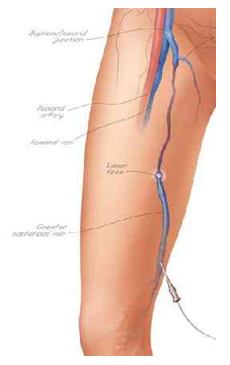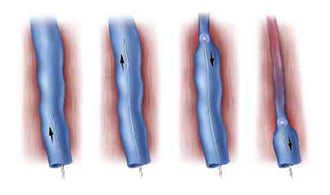Information for Patients
Vascular Surgery
Mr Wilson is a vascular surgeon whose specialist skills include dealing with: varicose veins, thread veins/spider veins, deep vein thrombosis, leg ulcers and excessive sweating disorders (hyperhidrosis). Mr Wilson is an aneurysm specialist and performs endovascular surgery. A comprehensive range of vein treatments undertaken by Mr Wilson includes: VNUS, endovascular therapy (EVLT/Celon), foam sclerotherapy, conventional sclerotherapy and conventional surgery.
Mr Wilson is also a specialist accredited general surgeon treating conditions such as hernias, gallstones skin lesions and lumps etc.
Following a consultation with Mr Wilson, a letter detailing the content of the consultation will be sent to your GP/referrer as soon as possible. If you are unable to attend your appointment, please contact the Outpatient Department as soon as possible as failure to attend without prior notice may incur an administration fee.
Patients having consultations for Varicose Veins
Mr Wilson offers a one stop consultation and diagnosis appointment when you attend outpatients. This will mean he will offer to perform a detailed ultrasound scan of your veins so that the specific problem you have can be identified and the treatment plan tailored to your specific situation. There will then be no further need for any further tests ahead of your treatment. Please see information to patients for costs. If you only want an initial general assessment consultation please inform Mr Wilson you do not want a scan at that time.
Insured Patients
Mr Wilson is a recognised specialist by all private medical insurers.
Insured patients should be aware of any non-insured excess arrangements with their policy as these charges are the patient's liability.
Your insurance company may request that a claim form is completed either by your GP or by Mr Wilson. If your insurer requests the latter, please bring the form to the consultation or send it to us for completion.
Uninsured Patients
Mr Wilson's fee for an initial consultation of up to 30 minutes is £180 and follow-up consultations of up to 15 minutes are £100. It is necessary for all patients consulting with Mr Wilson regarding varicose veins to undergo an ultrasound scan during the consultation which carries an additional cost of £170 for one leg or £220 for both legs. If you do not wish to undergo this ultrasound, please advise Mr Wilson during the consultation. Further tests/investigations such as blood tests and x-rays are charged in addition by the hospital. An invoice will be sent following the consultation and we request settlement within 7 days of receipt.
Fixed-price packages are available for surgical procedures following consultation.
Foam Sclerotherapy Information
About the Treatment
Foam sclerotherapy is a form of injection treatment suitable for varicose veins and larger areas of thread veins. A chemical liquid is mixed with air to form the foam used to inject the veins. The reaction causes a local inflammation which results in the veins blocking and therefore no longer being visible. It works by making the vein wall stick to itself, thus obliterating it. The compression applied after the injection is an essential part of the therapy. The foam can be identified inside the veins using ultrasound. This feature allows the foam to be guided into the veins requiring treatment and it will remain in this position once the compression pads and medical compression stockings have been applied.
Before Your Next Visit
You will need to wear medical compression hosiery following the treatment and it is, therefore, important that you obtain medical compression stockings to bring along to your treatment session. A Sigvaris lower limb prescription product catalogue will be provided for you to order these direct.
At the Clinic
A needle will be inserted into the vein requiring treatment. Depending on the nature of the vein problem, this may require only a single injection if the main vein trunks are being treated first. Multiple injections, however, may be required, particularly for treatment to large areas of thread veins. The foam solution is injected through the needle and controlled using ultrasound. When the appropriate amount of foam has been injected, the needle will be removed. Cotton wool pads are applied to the treated area and held in place with an adhesive dressing. The medical compression stocking will then be put on to provide the required compression. Usually, only one leg is treated at one visit and repeat injections will be required if both legs are affected or you have many veins in one leg.
Afterwards
You will be encouraged to walk and undertake normal day-to-day activities. The stocking must remain in position together with the cotton wool pads for a full 72-hour period. After this time, the medical compression stocking, dressing and cotton wool pads may be removed. Normal bathing is permitted. The medical compression stocking does not need to be used at night after this initial period but must be used throughout the day for a further 7 days. The success of the injection treatment relies upon the pressure that the medical compression stockings apply to the injected area. Wear the medical compression stockings for a minimum of 10 days following treatment.
Driving
You will be advised not to drive within the first 12 hours following treatment but will be able to do so after this period as long as you deem it comfortable and safe (please see complications.)
What to Expect After the Injections
Over the first few weeks, following the injection, any slight discomfort, redness, hardness or tenderness at the injection site(s) should gradually subside. If there is excessive redness, swelling or tenderness, this means you should rest more with the leg raised so that the heel is higher than the hip.
While most patients experience no problems after injection of varicose veins, a small number may experience one or more of the following:
- A persistent, hard 'cord' in the line of the vein
- Some old blood may be trapped in the vein as it responds to treatment and occasionally this requires needle pricking and expressing when you are seen for review after treatment
- Brown staining of the skin in the line of the vein
- Rarely, ulceration of the skin at the injection site
- Failure of the injection to obliterate the vein
Visual disturbance: very rarely, it has been reported in medical literature that some blurring of vision has occurred following foam sclerotherapy. This is fully recoverable and tends only to occur in the first 12 hours following treatment. For this reason, you will be advised not to drive yourself from the clinic after treatment or in the first 12 hours following treatment.
How Long Before My Veins Go?
Many veins take some time before they respond to the injection treatment. It may be many (6 or more) months from the completion of treatment before the final result is noticeable.
VNUS Celon and EVLT Vein Treatment Information
What are VNUS Celon and EVLT?
Endothermal Ablation Therapy NICE Recomendation 1.
VNUS/Celon and EVLT are the two latest techniques used to treat varicose veins that are caused by leaking valves in the groin and thigh. The techniques replace the need for the more traditional operation that requires a cut in the groin and stripping of the vein in the thigh. The principle behind both techniques is to place a catheter (fine tube) up the thigh vein to the groin or behind knee and then, using ultrasound scanning to see the catheter, withdraw it down the vein while applying heat to the catheter tip. The effect of the heat on the vein is to make the vein tissue contract and fibrose over several months. This process "closes the vein" so that blood can no longer flow back down it causing the back pressure that creates the varicose veins.
How do the two procedures differ?
The principle is the same. The procedures differ in the method used to apply the heat - VNUS uses radiofrequency waves across metal tips to the catheter and EVLT uses a laser light.
Is this inpatient or outpatient surgery?
These techniques can allow all varicose vein treatment to be done as an outpatient however this approach may involve several visits to treat all the veins and therefore is a longer process than inpatient treatment. Please ask for more details regarding your own personal situation.
What are the benefits?
Possible benefits include: less discomfort, less bruising and a quicker return to activity. These are more likely to be evident to patients undergoing operations on both legs or for recurrent veins. The procedure removes the need for larger scars and there are no stitches.
What are the downsides?
The complications are similar to those from standard varicose vein surgery but they appear to be less common. Effects include: bruising, discomfort in the thigh and areas of skin numbness. Very rarely because heat is being used, a skin burn can occur. You should remember that as these are newer techniques and we do not yet have enough information about the long-term durability of these techniques. We do have good 5 year outcome information and these techniques are as good as any other previous surgery. They can also be repeated and do not preclude the ability to do more conventional surgery if necessary.
NICE recommendation no 1 for varicose veins treatment where there is reflux back pressure is endothermal abalation therapy
Is other treatment necessary?
As with conventional surgery, you will have little cuts made over all the varicose veins where they will be hooked out (phlebectomy). This is the best cosmetic tidy up procedure.
The Catheter Insertion in the Thigh Vein for VNUS/EVLT and Closure Procedure

The Principle of VNUS/EVLT Catheter Closure of the Main Varicose Vein

Microsclerotherapy Information
About the Treatment
Injection (sclerosant) therapy is usually only suitable for relatively small varicose veins and thread veins which are unsightly but cause no symptoms. It works by making the vein wall stick to itself, thus obliterating it, and the compression applied after the injection is an essential part of the therapy.
Before Your Next Visit
You will need to wear medical compression hosiery following the treatment and it is, therefore, important that you obtain stockings to bring along to your treatment session. Sigvaris stocking details will be provided for you to order direct.
At the Clinic
A small amount of fluid is injected into the vein at 1 or more sites and cotton wool pad is applied. A stocking is then put onto the leg. Usually only 1 leg is treated at 1 visit and repeat injections will be required if both legs are affected or if you have many veins in 1 leg.
Afterwards
You will be encouraged to walk and undertake normal day-to-day activities. After 72 hours you should remove the stocking and cotton wool pads and replace the stocking. This should be worn at all times during the day but can be removed in bed and when taking a bath or shower. You may drive as soon as you feel comfortable. The success of the injection treatment relies upon the pressure that the stocking applies to the injected area. Wear the stocking for a minimum of 2 weeks following a treatment.
What to Expect After the Injections
Over the first few weeks following the injections, any slight discomfort, redness, hardness or tenderness at the injection site(s) should gradually subside. If there is excessive redness, swelling or tenderness, this means you should rest more with the leg raised so that the heel is higher than the hip.
Whilst most patients experience no problems after injection of varicose veins, a small number may experience 1 or more of the following:
- A persistent hard 'cord' in the line of the vein
- Brown staining of the skin in the line of the vein
- Rarely, ulceration of the skin at the injection site
- Failure of the injection to obliterate the vein
How Long Before My Veins Go?
Many veins take some time before they respond to the injection treatment. It may be many (6 or more) months from the completion of treatment before the final result is noticeable. The type of veins treated by injections can occur again and, often for the long term, many treatments may be necessary.






